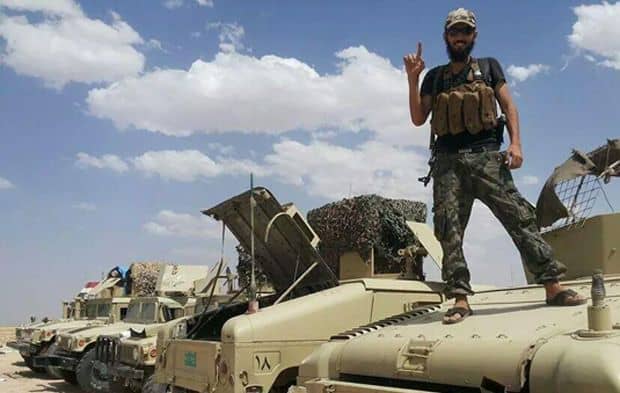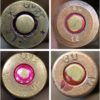Introduction

Never mind that the vehicle is a boxy, lumbering, second-hand set of wheels with a top speed of just 60 mph. To some of the fighters of the Islamic State in Iraq and Syria, the U.S. M1117, aka the Guardian Armored Security Vehicle, has become their favorite ride.
Or so says Jeremy Binnie, editor of Jane’s Terrorism and Security Monitor, who has monitored propaganda sites for reports of jihadis toting, towing or tooling around in some of the millions of dollars’ worth of U.S.- and other foreign-built military equipment that ISIS captured after it swept into northern Iraq in early June.
A promotional video by the manufacturer, Textron Marine and Land Systems, touts the four-wheel-drive, amphibious vehicle as “survivable,” due to its armor, and “lethal,” with its mounted grenade launcher and heavy machine gun. The vehicles, which can cost more than $600,000 each, are everything, apparently, that the modern militant could ask for.
“I’m sure Textron will be very happy,” Binnie said. “Their vehicle has the thumbs up from the Islamic State.”
By authorizing the first of dozens of airstrikes against militants in Iraq on Aug. 8 and dispatching more than 1,000 troops there as military advisers, President Barack Obama has sent U.S. forces back to a conflict that many Americans wanted to forget.
In battles from Afghanistan to Iraq, the United States defeated conventional forces equipped mainly with Soviet-design hardware. Now as the United States conducts air sorties in areas controlled by ISIS, the United States faces the prospect of having some of its own modern weapons systems turned against its military forces and those of its Iraqi allies.
“It’s a cautionary tale, in terms of the consequences of sending more arms to the Kurds and the Iraqi security forces,” said William Hartung, author and director of the Arms and Security Project at the Center for International Policy in Washington. “I think once you send this kind of equipment into the middle of a civil war, it’s hard to say where it will end up.”
Michael Pregent, a former U.S. Army officer who speaks Arabic and has worked for the Defense Department in Iraq as a military and political analyst, estimated that the militants have captured up to 60 of the three heaviest pieces of U.S.-built equipment in the Iraqi arsenal — M1 Abrams tanks, Bradley Fighting Vehicles and M109 self-propelled howitzers.
Pregent, who is now an adjunct lecturer at National Defense University, said some of these weapons were used in attacks on the Kurdish Peshmerga militia forces defending their semi-autonomous region. ISIS’ threat to the Kurdish capital of Erbil triggered the United States’ intervention.
A video of the first U.S. airstrikes shows a U.S.-made F/A-18 Hornet, which cost roughly $61 million, bombing what appears to be a U.S.-made M198 towed howitzer, which cost $527,000, in the hands of insurgents. Both Pregent and Birnie said the artillery piece was clearly identifiable in the video.
Pregent said he would expect that at least some U.S. airstrikes have targeted captured U.S.-built military equipment. Lt. Col. James Gregory of the Pentagon Press Office called that “speculative” and declined to discuss what ISIS may or may not have captured.
The jihadis claimed to have captured at least one abandoned M1 Abrams tank, and have posted photographs of flatbed trucks hauling Humvees to unknown destinations. But many of the photos on the Web purporting to be of captured U.S. equipment show Russian equipment instead.
When the Iraqi government announced in 2008 that it planned to spend almost $11 billion on weapons for its military, The Long War Journal reported that these purchases demonstrated Iraq’s resolve to create “a military capable of protecting its own borders.” Instead, the Iraqi National Army in early June withdrew from huge swathes of northern Iraq in the face of underwhelming odds.
Hartung estimated that since 2005 the United States has sold about $8 billion worth of weapons to Iraq. According to a July report by the Congressional Research Service, prior to the U.S. withdrawal in December 2011, Iraq purchased 140 M1A1 Abrams tanks, at a cost of about $6 million each, as well as two naval vessels and border monitoring equipment.
The CRS said Iraq has also struck a deal to pay $6.5 billion for 36 F-16 combat aircraft, the first of which scheduled for delivery next month. The F-16s were supposed to be based at Balad Air Base north of Baghdad, but InsideDefense.com reported Aug. 15 that preparations for their arrival were suspended because of the threat.
The U.S. also sold or leased Iraq 30 Apache helicopters in a deal worth $6.17 billion, the CRS report said, but delivery was held up by Congress until recently over concerns that the government might use them in sectarian clashes.
Iraq has also consided purchasing a $2.4 billion air defense system that includes 681 Stinger missiles, three Hawk antiaircraft batteries, and other equipment. The Pentagon has said the Stingers can only be operated as part of the larger air defense system they were designed to serve, not by militants on their own.
ISIS may not be able to use a lot of the equipment, Pregent said, because the fighters lack the training and facilities to operate and maintain it. He said that, based on his experience working with Iraqi forces, as many as half of the 60 largest weapons seized may have been broken down and in need of repair when they were captured.
“Every advisor who’s ever been with the Iraqi military knows that its biggest headache was to get the Iraqis to maintain this equipment,” Pregent said.
Binnie said untrained militants would find it a “trick to master” firing their new U.S. tanks and artillery, and probably couldn’t use them accurately against targets they couldn’t see in front of them. “You probably couldn’t hit much besides a city,” he said.
While the larger vehicles are more photogenic, Binnie said the small arms and ammunition caches seized by ISIS may have more military value.
“That is probably the main thing for the Islamic State guys, is just capturing large quantities of infantry weapons and ammunition, the stuff they’re using anyway,” Binnie said. “They burn through a lot of ammunition — rocket-propelled grenade rounds, mortars, bullets. Capturing that is probably going to be a major boon.”
Most militants, he said, would “prefer a land cruiser to a Humvee,” he added. “It’s just going to be easier for them to keep running.” As evidence of the low regard they have for the American military vehicles, he said that after the militants captured the Iraqi Army’s Humvees, it loaded some of them up with explosives for use as car bombs.
Pregent said even captured U.S. ammunition may not be as useful to the militants as it might seem, because they probably prefer their rugged if less accurate Soviet-designed weapons to U.S. military arms.
As for the M1117 Guardians, Pregent said he could see why they would appeal to young militants. “It’s a sexy vehicle,” he said. “It looks great.” But he estimated that there are probably fewer than 10 of them in jihadi hands. “If they’re not destroyed already.”
Read more in National Security
National Security
Fired Los Alamos nuclear expert files appeal
Whistleblower penned politically unpopular article


Join the conversation
Show Comments